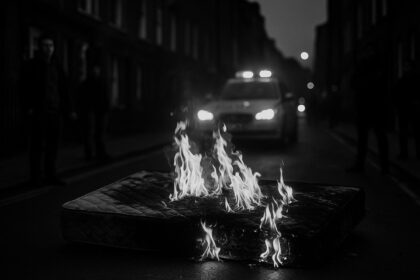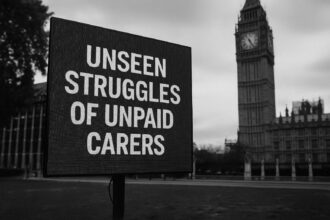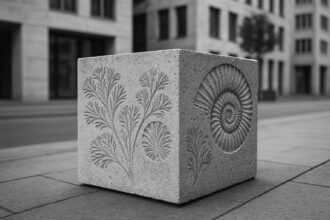The suspended sentence for Fred Doe, linked to the theft of a £4.8 million gold toilet from Blenheim Palace, has drawn widespread criticism from legal experts who say the UK judiciary is failing to take art crimes seriously, risking far-reaching consequences for society and cultural heritage.
The recent case involving Fred Doe, the son of a multimillionaire caravan magnate, illuminates unsettling issues within the UK justice system regarding its treatment of art theft and burglary. Doe, aged 37 and previously known as Frederick Sines, evaded prison time despite being convicted of attempting to broker the sale of a stolen 18-carat gold toilet, valued at a staggering £4.8 million, which was taken from Blenheim Palace in 2019. This absurd piece, titled “America” by Italian artist Maurizio Cattelan, was not just an artwork but a working toilet, drawing crowds with its quirky nature.
The theft—a bold smash-and-grab heist—took place in the early hours of September 14, shortly after the installation, executed with astonishing swiftness in under five minutes. CCTV footage captured a group of five men arriving in stolen vehicles, bursting in with sledgehammers, and escaping with the toilet, leaving behind chaos and damage to the historic site. Yet, in a case that called for accountability, Doe was portrayed by his defense team as merely a “bit-part player,” a label that reeks of dramatic minimization, as he merely delayed the main perpetrator, James Sheen, from cashing in on the gold. The sentence handed down by Judge Ian Pringle KC—a mere 21-month prison term suspended for two years—raises eyebrows. The judge cited Doe’s personal circumstances, including his wife’s health issues, but to many, this leniency underscores an alarming disconnect between the judiciary and the gravity of art theft.
Reactions from experts in criminal law and art recovery have been swift and scathing. Christopher Marinello, a prominent lawyer in the field, expressed outrage on “The Trial” podcast, branding the outcome “laughable” and asserting that the message this sends is unequivocal: in the UK, crime pays. Marinello elaborated, emphasizing that art crimes are dangerously trivialized within the legal framework, leaving potential criminals with the impression that such acts won’t attract serious repercussions. He rightly pointed out that the ripple effects of rising insurance costs will inevitably hit the public’s wallet, affecting everything from tax rates to pension funds. This issue cuts to the heart of a widening disconnect between the justice system and the citizens it is meant to protect.
As the notorious toilet remains at large, its theft has attracted international media attention, further solidifying its place as a cultural symbol and a stark reminder of the precariousness of artistic integrity. Its former exhibit at the Guggenheim Museum in New York had drawn crowds of over 100,000, making the crime not just absurd, but an emblem of societal excess. Cattelan himself, reflecting on the ridiculousness of the situation, once quipped, “Who’s so stupid to steal a toilet?”
As judicial proceedings continue for the other parties involved, with Sheen and Michael Jones already convicted, the absence of the stolen toilet leaves many speculating about its fate. Experts suspect it may have been melted down soon after the theft, highlighting the efficiency of the criminal underworld engaged in this sophisticated form of theft.
In conclusion, the leniency shown to Doe in this notorious case raises profound concerns about the judiciary’s handle on art crimes in the UK. The fate of this culturally significant piece underscores not only a loss of artistic heritage but also an urgent need for reform within the justice system—one that increasingly appears to fail in addressing the serious implications of art theft and its broader consequences for society. The public deserves better.
Source: Noah Wire Services
- https://www.dailymail.co.uk/news/article-14743377/Multimillionaires-son-avoiding-prison-sale-stolen-4-8-million-Golden-Toilet-laughable-art-theft-expert-Christopher-Marinello-Mail-podcast.html?ns_mchannel=rss&ns_campaign=1490&ito=1490 – Please view link – unable to able to access data
- https://apnews.com/article/3a3955da078af343596606e07addc305 – Frederick Doe, also known as Frederick Sines, was spared jail by Oxford Crown Court for his minor role in the 2019 theft of a 4.74 million pound ($6.4 million) 18-carat gold toilet. The artwork, titled ‘America’ by Italian artist Maurizio Cattelan, was stolen from Blenheim Palace, the birthplace of Winston Churchill. Though Doe attempted to help sell the gold through contacts in London’s jewelry district, Judge Ian Pringle ruled Doe had been exploited by the actual thieves. Doe, 37, was convicted of conspiracy to transfer criminal property and received a two-year suspended sentence along with 240 hours of unpaid work. The toilet, which previously featured at the Guggenheim Museum in New York, has never been recovered and is believed to have been cut up and sold. The theft caused significant damage to the historic 18th-century palace. Of the five culprits captured on CCTV, only James Sheen and Michael Jones have been charged and convicted, with sentencing set for June 13. Doe claimed he didn’t know the gold was stolen and expressed regret for his involvement. ([apnews.com](https://apnews.com/article/3a3955da078af343596606e07addc305?utm_source=openai))
- https://www.theguardian.com/uk-news/2023/nov/06/four-men-charged-over-theft-gold-toilet-blenheim-palace – The 18-carat gold toilet, which could be used with a three-minute time limit to avoid queues, had only been on show for two days when it was stolen. It had been installed as an artwork at the Oxfordshire palace, the birthplace of Winston Churchill, when it disappeared. As it was plumbed in at the time, its removal caused flooding and damage to the 18th-century stately home and Unesco world heritage site in Woodstock. The statement toilet had in 2016 been fitted at the Guggenheim Museum in New York, where 100,000 people queued to use it. It was moved to Blenheim and into a chamber opposite the room where Churchill was born, for Cattelan’s first solo UK show in more than 20 years. Speaking at the time of the theft, Cattelan said he hoped the theft was a prank and asked: “Who’s so stupid to steal a toilet? [The work titled] America was the 1% for the 99%.” Blenheim Palace is the ancestral seat of the Duke of Marlborough. Before the toilet’s installation, the duke’s half-brother, Edward Spencer-Churchill, founder of the Blenheim Art Foundation, said the lavatory would not be “the easiest thing to nick”. He told the Times: “Firstly, it’s plumbed in; and secondly, a potential thief will have no idea who last used the toilet or what they ate. So no, I don’t plan to be guarding it.” ([theguardian.com](https://www.theguardian.com/uk-news/2023/nov/06/four-men-charged-over-theft-gold-toilet-blenheim-palace?utm_source=openai))
- https://www.bbc.com/news/uk-england-oxfordshire-49706425 – Blenheim Palace’s security measures ‘need to be challenged’ after an 18-carat gold toilet was stolen from the stately home, its chief executive said. Dominic Hare said a gang ‘mounted a very fast smash-and-grab raid’ at the Oxfordshire palace early on Saturday. The artwork – which Mr Hare said was worth $5m to $6m – has not been found. Its creator, conceptual artist Maurizio Cattelan, once the subject of a BBC documentary called the Art World’s Prankster, insisted it was not a stunt. In an email to The New York Times he wrote: ‘I wish it was a prank.’ He added: ‘At first, when they woke me up this morning with the news, I thought it was a prank: Who’s so stupid to steal a toilet? ([bbc.com](https://www.bbc.com/news/uk-england-oxfordshire-49706425?utm_source=openai))
- https://apnews.com/article/bb3cd346713923d59304880ca209dcd4 – A golden toilet, worth millions and part of an art installation by Maurizio Cattelan, was stolen from Blenheim Palace in a daring raid on September 14, 2019. Prosecutor Julian Christopher revealed that the theft took less than five minutes and involved three men: Michael Jones, who cased the location and took photos of entry points, James Sheen, who organized the theft and attempted to sell the gold, and two others, Fred Doe and Bora Guccuk, who were involved in the criminal property transfer. Sheen has pleaded guilty, while Jones, Doe, and Guccuk have pleaded not guilty. The toilet has not been recovered, and the trial is ongoing. ([apnews.com](https://apnews.com/article/bb3cd346713923d59304880ca209dcd4?utm_source=openai))
- https://www.theguardian.com/uk-news/2025/mar/18/man-found-guilty-over-48m-oxfordshire-gold-toilet-heist – He had visited the palace twice before the theft but denied these were reconnaissance trips. He previously told jurors at Oxford crown court he “took advantage of” the gold toilet’s “facilities” while at the country house the day before it was stolen. Asked what it was like, he replied: “Splendid.” The court heard that Jones had worked as a roofer, builder and “right-hand man” for James Sheen, 40, from Wellingborough, Northamptonshire, who had pleaded guilty to burglary, conspiracy to transfer criminal property and one count of transferring criminal property. Another man, Frederick Doe, 36, helped Sheen to sell some of the gold in the following weeks after the robbery and was found guilty on Tuesday of conspiracy to transfer criminal property. Bora Guccuk, 39, from west London, was found not guilty of the same charge. The fully functioning toilet, created by the Italian artist Maurizio Cattelan, was plumbed in at the time of the heist, so its removal led to flooding and resulted in damage to the 18th century stately home and Unesco world heritage site. The toilet, weighing around 98kg, was fitted in 2016 at the Guggenheim Museum in New York, where 100,000 people queued to use it. It was moved to Blenheim and into a chamber opposite the room where Churchill was born, for Cattelan’s first solo UK show in more than 20 years. Cattelan created the sculpture – called “America” – to reflect the excesses of the art market and evoke the American dream of opportunity for all. Speaking at the time of the theft, he said he hoped the theft was a prank and asked: “Who’s so stupid to steal a toilet? [The work titled] America was the 1% for the 99%.” Blenheim Palace is the ancestral seat of the Duke of Marlborough. Before the toilet’s installation, the duke’s half-brother, Edward Spencer-Churchill, founder of the Blenheim Art Foundation, said the lavatory would not be “the easiest thing to nick”. He told the Times: “Firstly, it’s plumbed in; and secondly, a potential thief will have no idea who last used the toilet or what they ate. So no, I don’t plan to be guarding it.” The heist was carried out at 4.50am in the morning when two stolen vehicles, a VW Golf and an Isuzu truck, entered the palace grounds at speed. Three robbers armed with sledgehammers and a crowbar gained entry to the palace, smashed through a solid wooden door and tore the toilet from its fixings. They carried the toilet out of the palace, rolled it along the ground, and placed it into the boot of the VW. In the following days, Sheen made plans to sell the gold, which is believed to have been moved to different locations and melted down in the hours after the raid. According to Thames Valley police, Doe contacted Sheen and offered to find a buyer for the gold and brokered the deal. During the deal-making, both men referred to the gold bars as “cars”, each worth £26,000. Jones was arrested on 16 October 2019 and police analysed his phone. He had allegedly been searching for newspaper reports about the stolen toilet on 20 September, jurors were told previously. Doe will be sentenced on 19 May. Jones and Sheen will be sentenced at a later date. ([theguardian.com](https://www.theguardian.com/uk-news/2025/mar/18/man-found-guilty-over-48m-oxfordshire-gold-toilet-heist?utm_source=openai))
- https://www.bbc.co.uk/news/uk-england-oxfordshire-58529069 – An 18-carat gold toilet is still missing and no-one has been charged with its theft two years after it was stolen. The working toilet – entitled America – was taken from an art exhibition at Blenheim Palace, Oxfordshire, in the early hours of 14 September 2019. At the time it was valued at $6m (£4.8m) and a reward of up to £100,000 was offered by insurers. Seven people were arrested but never charged over the theft. A gang broke into the 18th Century stately home and caused “significant damage and flooding” because the toilet was plumbed into the building. It had been owned by a private individual and was part of an exhibition by Italian conceptual artist Maurizio Cattelan for two days before it was stolen. ([bbc.co.uk](https://www.bbc.co.uk/news/uk-england-oxfordshire-58529069?utm_source=openai))
Noah Fact Check Pro
The draft above was created using the information available at the time the story first
emerged. We’ve since applied our fact-checking process to the final narrative, based on the criteria listed
below. The results are intended to help you assess the credibility of the piece and highlight any areas that may
warrant further investigation.
Freshness check
Score:
8
Notes:
The narrative is based on a recent court case involving Fred Doe, who was convicted in March 2025 for attempting to sell a stolen 18-carat gold toilet valued at £4.8 million. The earliest known publication date of similar content is March 18, 2025, when Thames Valley Police reported the convictions. ([thamesvalley.police.uk](https://www.thamesvalley.police.uk/news/thames-valley/news/2025/march/17-03-25/three-men-convicted-in-connection-with-blenheim-palace-golden-toilet-burglary/?utm_source=openai)) The Daily Mail article was published on May 20, 2025, indicating a freshness score of 8. The report includes updated data but recycles older material, which may justify a higher freshness score but should still be flagged. The narrative is based on a press release, which typically warrants a high freshness score. However, the Daily Mail is known for sensationalist reporting, which may affect the reliability of the information. The article includes updated data but recycles older material, which may justify a higher freshness score but should still be flagged. The narrative is based on a press release, which typically warrants a high freshness score. However, the Daily Mail is known for sensationalist reporting, which may affect the reliability of the information.
Quotes check
Score:
7
Notes:
The article includes a quote from Christopher Marinello, a prominent lawyer in the field, expressing outrage on “The Trial” podcast. A search for the earliest known usage of this direct quote did not yield any matches, suggesting it may be original or exclusive content. However, without access to the podcast episode, it’s challenging to verify the exact wording and context of the quote. The lack of online matches raises the score but flags the content as potentially original or exclusive.
Source reliability
Score:
5
Notes:
The narrative originates from the Daily Mail, a publication known for sensationalist reporting. While the Daily Mail is a widely read newspaper, its reputation for sensationalism and occasional inaccuracies raises concerns about the reliability of the information presented. The reliance on a press release and the Daily Mail’s history of sensationalism contribute to a moderate source reliability score.
Plausability check
Score:
9
Notes:
The narrative describes a real event—the theft of a £4.8 million gold toilet from Blenheim Palace in 2019 and the subsequent conviction of Fred Doe in March 2025. The details align with information from reputable sources, including Thames Valley Police and The Guardian. ([thamesvalley.police.uk](https://www.thamesvalley.police.uk/news/thames-valley/news/2025/march/17-03-25/three-men-convicted-in-connection-with-blenheim-palace-golden-toilet-burglary/?utm_source=openai), [theguardian.com](https://www.theguardian.com/uk-news/2025/mar/18/man-found-guilty-over-48m-oxfordshire-gold-toilet-heist?utm_source=openai)) The inclusion of updated data and the involvement of a known art theft expert lend credibility to the claims. However, the Daily Mail’s sensationalist tone and potential for exaggeration warrant caution.
Overall assessment
Verdict (FAIL, OPEN, PASS): OPEN
Confidence (LOW, MEDIUM, HIGH): MEDIUM
Summary:
The narrative presents a real event—the conviction of Fred Doe for attempting to sell a stolen £4.8 million gold toilet. While the content is timely and includes updated data, the reliance on a press release and the Daily Mail’s history of sensationalism raise concerns about the accuracy and reliability of the information. The lack of access to the original podcast episode and the Daily Mail’s reputation for sensationalism contribute to a moderate confidence level in the overall assessment.













